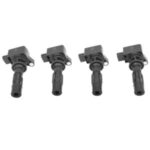Experiencing the dreaded check engine light in your Volkswagen and seeing the code P0420? It can be frustrating, but understanding what this code means is the first step to resolving the issue. The P0420 code generally indicates “Catalyst System Efficiency Below Threshold (Bank 1)”. In simpler terms, your car’s computer is telling you that your catalytic converter isn’t working as efficiently as it should be. While this might sound alarming, it’s often related to issues with your oxygen sensors.
When you encounter the P0420 code on your VW, it’s tempting to jump to conclusions and assume the catalytic converter itself is faulty. However, before you consider expensive repairs, it’s crucial to diagnose the problem correctly. Often, the culprit lies within the oxygen sensors (O2 sensors) that monitor the catalytic converter’s performance. These sensors play a vital role in ensuring your exhaust system is functioning correctly and your car is running efficiently.
To properly diagnose a P0420 code on your Volkswagen, it’s highly recommended to seek out a mechanic who specializes in German vehicles, particularly VWs. While general mechanics can be helpful, a specialist familiar with the intricacies of Volkswagen engineering will have the expertise to pinpoint the exact cause of the P0420 code. They will use specialized diagnostic tools to assess your O2 sensors and determine if they are sending inaccurate readings.
Once you’re at a reputable German car repair shop, ask them to specifically “scope out” your O2 sensors in relation to the P0420 code. This involves a detailed examination of the sensor signals to see if they are within the expected range. A skilled mechanic can then identify whether an O2 sensor is faulty and needs replacement. If a sensor replacement is indeed necessary, it’s strongly advised to purchase a genuine Volkswagen (VW) O2 sensor from a VW dealership. While aftermarket parts might be cheaper, genuine VW parts are designed to meet the specific requirements of your vehicle and ensure long-term reliability.
Replacing an O2 sensor on a VW isn’t necessarily a complex task for a DIY enthusiast. Typically, the O2 sensors are located underneath the car, near the catalytic converter. Depending on which sensor is identified as faulty (upstream or downstream), you’ll find it before or after the catalytic converter in the exhaust system. With basic tools, including a wrench, and a bit of patience, you can often replace the sensor yourself.
After replacing the O2 sensor, you’ll need to reset your car’s Engine Control Unit (ECU) to clear the P0420 code. Many auto parts stores, like AutoZone, offer free ECU reset services. Alternatively, you can use an OBD-II scanner to clear the code yourself. After resetting the code, it’s important to drive your car for about 100 miles or through approximately 20 engine start-up cycles to see if the P0420 code returns. This allows the system to recalibrate and confirm whether the issue has been resolved.
In conclusion, while Vw Code P0420 points to catalytic converter inefficiency, it’s often linked to faulty O2 sensors. Proper diagnosis by a German car specialist, using genuine VW parts for replacement, and a simple ECU reset can often resolve this issue. Remember, both O2 sensors are located underneath your VW, near the catalytic converter, not within the engine bay itself. Addressing this code promptly will help maintain your Volkswagen’s performance and ensure it runs efficiently.

